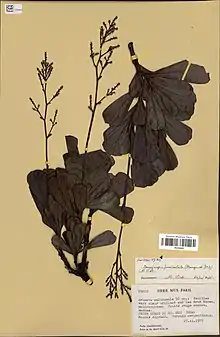| Beaupreopsis | |
|---|---|
 | |
| Scientific classification | |
| Kingdom: | Plantae |
| Clade: | Tracheophytes |
| Clade: | Angiosperms |
| Clade: | Eudicots |
| Order: | Proteales |
| Family: | Proteaceae |
| Subfamily: | Proteoideae |
| Genus: | Beaupreopsis Virot |
| Species: | B. paniculata |
| Binomial name | |
| Beaupreopsis paniculata | |
Beaupreopsis is a genus of plant in family Proteaceae, with just one species in the genus, Beaupreopsis paniculata.[1] It is native to New Caledonia on the south of Grand Terre.[2] Its habitat is from open maquis, to mountain area as low scrub, on a substrate of eroded ultramafic rocks.
Characteristics
The plants are shrubs, rarely exceeding 1.50 m in height, with thick branches, scattered and few. They have pseudo-whorled leaves (5-10 x 0, 20-0, 60 cm), more or less toothed or lobed at the apex, cuneate at the base, leathery, venation slightly prominent, petiole short and robust.
Flowers are small, white or pinkish in terminal panicles from 20 to 50 cm. The fruits are small and hairy, containing a single seed.
Ecology
The soils of ultramafic rocks, which are mining terrains, have been a refuge for many native plant species of New Caledonia because they are toxic and their mineral content is poorly suited to most foreign species of plants.[3] On New Caledonia examples of such soils commonly have an excess of magnesium, plus unusually high concentrations of phytotoxic compounds of heavy metals such as nickel.
Often thick, magnesite-calcrete caprock, laterite and duricrust forms over ultramafic rocks in tropical and subtropical environments. The floral assemblages associated with highly nickeliferous ultramafic rocks are indicative tools for mineral exploration. [4] [5]
Systematics
The genus Beaupreopsis is most closely related to the genera Cenarrhenes (Tasmania) and Dilobeia (Madagascar).[6]
References
- ↑ "Beaupreopsis — the Plant List".
- ↑ Flore de La Nouvelle-Calédonie et Dépendances. Paris: Muséum national d'histoire naturelle, Laboratoire de phanérogamie. OCLC 468459079. Retrieved 12 May 2021.
- ↑ Dossier > La flore de Nouvelle-Calédonie - Première partie
- ↑ Golightly JP (1981). "Nickeliferous Laterite Deposits". Economic Geology. 75: 710–735. doi:10.5382/AV75.18. ISBN 978-1-9349-6953-3.
- ↑ Melfi AJ, Carvalho A (1983). Geochemical principles of lateritic nickel ore formation. Proceedings of the 2nd International Seminar on Lateritisation Processes. São Paulo, Brazil. pp. 119–135. OCLC 954620695.
- ↑ Sauquet HP, Weston CJ, Anderson NP, Barker DJ, Cantrill AR, Savolainen V (2009). "Contrasted Patterns of Hyperdiversifaction in Mediterranean Hotspots". Proceedings of the National Academy of Sciences of the USA. 106 (1): 221–225. Bibcode:2009PNAS..106..221S. doi:10.1073/pnas.0805607106. PMC 2629191. PMID 19116275.